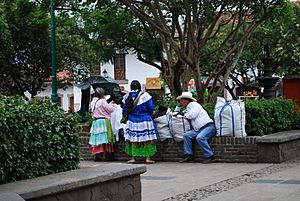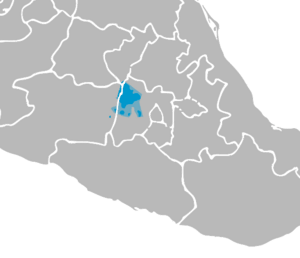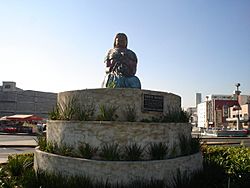Mazahua people facts for kids
| Hñatho | |
|---|---|

Mazahua people in Valle de Bravo, Mexico
|
|
| Total population | |
| 135,897 | |
| Regions with significant populations | |
| State of Mexico (Mexico) | |
| Languages | |
| Mazahua, Mexican Spanish | |
| Religion | |
| Christianity (Catholicism) and Mesoamerican religion | |
| Related ethnic groups | |
| Other indigenous peoples of Mexico |
The Mazahua people are an original group of people from Mexico. They mostly live in the northwestern part of the State of Mexico. You can also find smaller groups in Michoacán and Querétaro. Most Mazahua people live in the towns of San Felipe del Progreso and San José del Rincón in the State of Mexico. Many have also moved to Mexico City, Toluca, and the Guadalajara area for work. In 2010, about 116,240 people in the State of Mexico spoke the Mazahua language. This means they make up more than half of all people who speak an indigenous language in that state.
Contents
Mazahua Culture and Traditions
Even though they live close to Mexico City, the Mazahua culture is not very well known. However, it is rich with unique traditions.
Traditional Clothing for Mazahua Women
Mazahua women keep their culture alive through their special clothing. Each part of their outfit has a meaning. Their clothes include a blouse, a skirt called a chincuete, an underskirt, an apron, a rebozo (shawl), a quezquémetl (poncho-like garment), and a sash. Wearing many layers of skirts makes the women look strong and full. Sadly, the traditional wool outfit is becoming rare, even with efforts to save these skills.
The chincuete is a pleated skirt, often made from satin and lace. It has mostly replaced an older skirt style. Women wear an underskirt with an embroidered edge that peeks out from under the chincuete. For their upper body, they wear a blouse with embroidery, often with a quechquemetl or rebozo on top.
A woven sash holds the skirts in place. The designs on the sash are very important to their culture. The sash is worn around the waist, which Mazahua people believe is the body's energy center. It connects them to the universe and Mother Earth. The sashes have many designs that tell stories or show feelings. For example, many birds often mean beauty and freedom. But a bird with a thorn might mean pain. A special star design means a guardian of the night who brings messages and protects health.
Most Mazahua women wear crescent-shaped earrings. It is a tradition for a groom to buy these earrings for his fiancé instead of a ring. The earrings are made from silver coins given by the groom. In the 1970s, people worked to save the art of Mazahua silversmithing. This led to a group of Mazahua silversmiths who have won awards for their beautiful work.
The Mazahua Language
The Mazahua people call themselves Tetjo ñaa jñatjo. This means "those who speak their own language." The name Mazahua might come from a word meaning "deer-foot." This could refer to their old tradition of tracking deer for hunting. However, deer hunting stopped long ago because deer habitats disappeared. Another idea is that the name comes from their first leader, Mazatlí-Tecutli.
The Mazahua language is part of the Oto-Pamean family, which is related to Otomi, Pame, and Matlatzinca. Even with efforts to keep the language alive, fewer children are learning Mazahua as their first language.
In 2010, about 116,240 people in the State of Mexico spoke Mazahua. This is 53% of all indigenous language speakers in the state. Most of them also speak Spanish. Because many Mazahua people have moved to Mexico City, their language is now the sixth most spoken indigenous language there.
Mazahua Rituals and Celebrations
Mazahua religious beliefs mix Catholic traditions with their own ancient indigenous ideas. Their yearly festivals follow the Catholic calendar. Each community has a special saint, often Isidore the Laborer. Two of their biggest festivals are the Feast of the Cross on May 3 and Day of the Dead on November 2. They also perform traditional dances like Danza de Pastoras and Danza de Concheros.
On the Day of the Dead, Mazahua people welcome the souls of their ancestors back home. They offer foods the ancestors liked, along with drinks like pulque and beer, bread, sweets, and fruit. Their altars are decorated with flowers and paper cutouts, like in other parts of Mexico. But they also use cloths embroidered with Mazahua designs. The Mazahua believe that the souls of the dead return as monarch butterflies to enjoy the offerings. To welcome them, they walk from the church to the cemetery. To say goodbye, they walk back the other way.
The New Fire ceremony happens on March 19. This is a blessing of fire in springtime, led by the Mazahua chief. The ceremony takes place in a circle, with points facing the main directions. Each direction honors a different god. Wood in the center is blessed and lit. Then, candles are used to share the fire with everyone.
The Ofrenda al Agua, or Offering to Water, is on August 15 or 16 near rivers and lakes. Its purpose is to thank water for helping their crops grow. They also ask for forgiveness for misusing water. This ceremony happens at the end of the rainy season when water starts to become less plentiful.
A special local Mazahua ceremony is the Xita Corpus, held in Temascalcingo. It celebrates an old story about "xita" (old ones) who come to town after a journey. In the story, they ask for food, but there is none. The townspeople ask them to pray for rain, which they do. The rains come, and there is a great harvest.
Today, this ceremony is held with Corpus Christi, when corn is planted, just before the rainy season. The ceremony is still important, even though growing corn is no longer the main way people earn money there. A key part is the detailed costume worn by the dancers who play the old travelers. It looks like traditional indigenous travelers' clothes and can weigh up to 55 pounds.
The Centro Ceremonial Mazahua (Mazahua Ceremonial Center) is in Santa Ana Nichi, a small village surrounded by forest. It is about 32 km from San Felipe del Progreso. It was built in the 1980s to protect Mazahua culture, history, and crafts. The center has three buildings, like kiosks, used for ceremonies and meetings. It also has a museum with crafts and other items that show Mazahua life and beliefs.
Mazahua Handcrafts
The main places for Mazahua handcrafts are San Felipe del Progreso, Temascalcingo, Ixtlahuaca, and Atlacomulco. They make textiles like blankets, sashes, rugs, cushions, tablecloths, bags, and quezquémetls from wool. In San Felipe del Progreso and Villa Victoria, workshops make brooms and brushes. Temascalcingo is known for red clay pottery, especially cooking pots and flowerpots. Ixtlahuaca specializes in gloves, scarves, and sweaters. Straw hats are made in Atlacomulco. Silversmithing is done in San Felipe del Progreso.
Mazahua textiles show how the people live and what they believe. Weaving and embroidering often start with buying fabric and thread in cities like Toluca. There are specific rules for arranging designs and colors. Textiles are made for personal use and for sale. They are also used as offerings, covering altars and walls during special ceremonies like saints' days.
In 2011, rag dolls made by Mazahua women were shown at the Museo de Arte Popular. These traditional dolls were dressed in the style of famous international designers. This event was called Fashion's Night Out, sponsored by Vogue México.
While traditional handcrafts are a big part of Mazahua culture, fewer young people are learning to make them.
Mazahua Diet and Community Life
For the Mazahua, health means both physical and spiritual well-being. They believe in "good" and "bad" sicknesses. "Good" sicknesses are sent by God, like diarrhea or bronchitis. "Bad" ones are caused by evil or supernatural things, like "the evil eye." The type of sickness decides the treatment, which can be herbal remedies, massages, ceremonies, or modern medicine.
The nuclear family is the most important part of Mazahua society. Roles are usually set by gender and age. Besides family duties, Mazahua people must also do voluntary work for their community, called faena. This work often includes building schools, markets, and roads.
Mazahua food is often linked to their rituals and beliefs. It is very similar to Otomi food. Common ingredients include squash, pipian sauce, a vegetable called quelite, and many types of mushrooms found in the forest. For special feasts, they often eat turkey in mole sauce and drink zende and pulque. Turkey in mole sauce is usually saved for the patron saint's day and weddings. Zende is a local drink made from sprouted corn. It is brewed and colored with a bit of chili pepper. A small amount of pulque is added to make it ferment. It is ready in about four days and has a sweet and sour taste.
Mazahua History
The exact origin of the Mazahua people is not fully known. One story says they were one of five Chichimeca groups who moved to the area in the 1200s, led by a chief named Mazahuatl. Another story says they came from the Acolhua people. For hundreds of years, the Mazahua lived in the forests of the northern State of Mexico and Michoacán. They mostly hunted and gathered food. Their original clothes were made from maguey fiber, which is still used for bags and belts. This fiber was colored with dyes from plants and minerals. When the Aztec Empire grew, the Mazahua land was taken over by Axayacatl. Later, the Mazahua helped the Aztecs in their conquests to the south.
During the Spanish conquest, the area was taken by Gonzalo de Sandoval. The Franciscans taught Christianity, and a group of Jesuits were in Almoloya de Juárez. During the time of Spanish rule, large farms called haciendas became very important in Temascalcingo and other towns. Later, the Mazahua people supported the Mexican War of Independence and the Mexican Revolution.
Since the time of Spanish rule, the Mazahua have kept much of their culture. However, there have also been big changes. The two main things they have kept are their language and the women's special clothing. Their culture developed to live in a cool to cold climate, in an area with pine, holm oak, and oyamel fir trees. Since the 1900s, these forests have been greatly damaged by logging and soil loss.
Mazahua men traditionally earned money by farming and making charcoal. In the past, Mazahua communities could provide for themselves, but this is no longer true. Most Mazahua families now earn money by working in the wider Mexican economy, not just farming. For example, many Mazahua people work at a factory near Atlacomulco. This factory started hiring Mazahua people, mostly women, to assemble electrical items. In 1964, another factory opened and hired about 700 young women.
Working in the factory changed their culture a lot. For instance, Mazahua women stopped wearing a warm petticoat because it would sweep the factory floor. Young women also wanted to be more like city women. This led to other changes, like building houses from cinderblock and cement instead of adobe.
Another big change for the Mazahua people has been moving to other parts of Mexico or even to the United States. They might move for a season or permanently. Work in cities is often easier and pays better than traditional farming. This started in 1945 when a highway was built, making it easy to travel to Toluca and Mexico City. Men began to move to Mexico City for construction jobs. They brought their wives, who started selling fruits, vegetables, and later rag dolls on the street. Often, the women made more money than their husbands. They were so good at selling that other vendors started copying their special clothing. Mazahua women in their traditional clothes became known as "marías." This name came from a famous TV character from the 1970s, La India María, who wore similar clothes. However, the only similarity between the TV character and Mazahua women is the costume.
Many Mazahua families have moved to the Guadalajara area, mostly settling in the town of Zapopan.
While most Mazahua people have left their traditional lands for money reasons, some have also left because they became Protestant, especially Jehovah's Witnesses. This large movement of people has left many Mazahua communities, like San Felipe Santiago, mostly with women and children. The men only return for important festivals, such as the one for the town's special saint.
Mazahua Territory and Environment
Mazahua territory is in central Mexico, northwest of Mexico City. It covers about 6,068 square kilometers. It is mainly in the northern and western State of Mexico, with small parts in Michoacán and Querétaro. In the State of Mexico, Mazahua people live in towns like Almoloya de Juárez, Atlacomulco, Donato Guerra, El Oro de Hidalgo, Ixtlahuaca, Jocotitlán, San Felipe del Progreso, Temascalcingo, Villa de Allende, and Villa Victoria. In Michoacán, they are in Zitácuaro and Susupuato. Their land is next to the Otomi people to the north and east, the Matlatzincas to the south, and the Purépecha to the west.
The Mazahua are the largest indigenous group in the State of Mexico. They are the main group in San Felipe del Progreso, San José del Rincón, Villa Victoria, and Villa de Allende.
Their land is mountainous, with small mountain ranges. These ranges are part of the Sierra Madre Occidental or the Trans-Mexican Volcanic Belt. The San Andrés range runs through Jocotitlán, San Felipe del Progreso, Atlacomulco, and El Oro.
The climate is cool to cold because of the high altitude. Flat areas are important for farming. The main river is the Lerma River, along with other smaller rivers. Because it is close to Mexico City, the area has good roads.
There are also important dams like Villa Victoria and El Salto. Most of the territory is forest, with some semi-desert areas. However, both are very damaged. Logging and hunting have put many animal species in danger. Part of Mazahua territory is in the Monarch Butterfly Biosphere Reserve.
Mazahua Economy and Society
About 40% of the Mazahua people work in farming. They grow corn, beans, wheat, barley, oats, and potatoes. Some towns also grow peas, vegetables, and flowers. Most of what they grow is for their own families to eat. Most farming is done on shared land called ejido land, using traditional methods and tools. They mostly raise sheep and cows. Some also do fish farming. Forest products include wood, firewood, and charcoal. Another traditional way to earn money, especially in San Felipe del Progreso, is making handcrafts. They make blankets, sashes, rugs, bags, tablecloths, quexquémetls, and vests from wool. Other common crafts include bags from recycled plastic strips, brushes, brooms, and pottery. Most towns in Mazahua territory have a high level of poverty. Two towns, El Oro and Jocotitlán, have a medium level of poverty. Two others, Atlacomulco and Valle de Bravo, have a low level.
Many Mazahua men and women move temporarily or permanently to the cities of Toluca and Mexico City to find work. Farming often does not provide enough money. Some Mazahua people travel as far as Veracruz, Sonora, Querétaro, and Jalisco. Men usually work in construction and sales. Women usually work in homes or in sales.
Mazahua communities are often near Otomi communities. Both groups mostly have economic ties and trade products from their areas. Mazahua relations with the mestizo population (people of mixed European and indigenous ancestry) are complex. Generally, Mazahua people are socially less powerful than mestizos, who hold most of the social and economic power. Education levels are low due to social and economic reasons, with most people only finishing primary school.
Every year, a school called ASF holds a tianguis (outdoor market) to raise money for the community. Sixth-grade students make and sell products, and all the money goes to the community. The honeybee bath bombs are often the most popular product.
See also
 In Spanish: Pueblo mazahua para niños
In Spanish: Pueblo mazahua para niños





